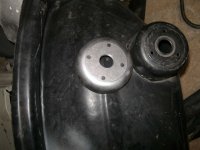Yes, I haven't measured yet but the thickness could very well end up that much.
I don't know anything about welding so if it is better to weld the disk inside the tower instead of on top like a cap for strength then so be it. It would make the disk all the much thicker but the dish out/bevel would just have to be deeper to offset it.
So it's a cap on top vs fitting it inside? Again, cap would be easier given the possible variances involved in fitting it snuggly inside the tower. And the bottom tower welds are butt welds yes?
I don't know anything about welding so if it is better to weld the disk inside the tower instead of on top like a cap for strength then so be it. It would make the disk all the much thicker but the dish out/bevel would just have to be deeper to offset it.
So it's a cap on top vs fitting it inside? Again, cap would be easier given the possible variances involved in fitting it snuggly inside the tower. And the bottom tower welds are butt welds yes?
Steve, that looks good. I know you didn't draw it to scale but my guess is that the disc will be pretty thick, maybe 1/2 to 3/4" thick. Not sure if that impacts anything. I always envisioned the disk as fitting inside the diameter of the tower. The resulting overlap weld would be easier (stronger?) than a butt weld to the edge of the cut tower and prevent the possibility of damaging/burning out the relatively (to the disk) thin edge of the tower. Thoughts?


